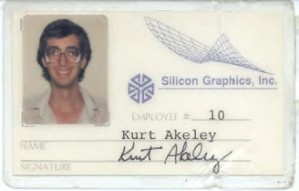If you have been working in computer graphics for 20 year or more, this is your meeting.
If you have been working in computer graphics (i.e., getting paid for it) since 1991 or earlier, and plan to attend Siggraph 2012, GraphicSpeak and Jon Peddie Research invites you to come by the Siggraph Computer Graphics Pioneers’ reception, Tuesday night August 7 at 6:00 pm, Los Angeles Convention Center Room 511 B/C.

Silicon Graphics co-founder Kurt Akeley is this year’s featured speaker. He will offer reflections on OpenGL at its 20th birthday (or it could be “anniversary”). Akeley was part of the founding Silicon Graphics team in 1982 and worked there for almost 20 years. During that time he led the development of several high-end graphics systems, including GTX, VGX, and RealityEngine. He’s also known for his pioneering work on OpenGL, the industry-standard programming interface for high-performance graphics hardware.
Culminating a multi-year effort by several industrial partners, the OpenGL 1.0 specification was finalized on June 30, 1992. Since then OpenGL has remained at the forefront of interactive computer graphics—it is as vibrant today as it was in 1992. Akeley will briefly describe the history of the initial development of OpenGL, then discuss at more length various factors he believes have contributed to its success, including in particular its design as an architecture. He’ll also touch on factors that were thought to be important at the time but may not have turned out to be and on errors that were overcome.
In addition, Akeley will say a few words about light field photography and the Lytro camera, which have substantial parallels to computer graphics and that offer another opportunity for a standard setting.
Computer Graphics Pioneers provides mentoring for those interested in working in computer graphics, and the group functions as a networking group for finding future work.
If you’ve been at pushing pixels around for 20 years or more and aren’t a Pioneer, contact Jon Peddie; he really really wants to hear from you. It is a goal of the Computer Graphics Pioneers to involve more people in the group and to increase its role in recognizing the people who helped create this industry. The group is especially interested in finding international pioneers whose work may not be as well known in the U.S. and other countries as it should be.





